Unit 5 First aid学案(新人教版必修5)
人教版高中英语必修5《Unit 5 first aid》教案

人教版高中英语必修5《Unit 5 first aid》教案人教版高中英语必修5《Unit 5 first aid》教案【一】一、教学内容分析本单元以“急救”为中心话题。
本案例把教材的Warming up 和Reading部分结合起来,旨在通过教学,使学生了解相关的急救知识,并能用所学的有关first aid的知识,根据不同情况提出急救措施。
同时通过教学激发学生进一步学习急救知识的兴趣和树立安全意识,意义重大。
二、教学目标1、语言目标:学习掌握教学内容中的重点字、词、句;2、能力目标:阅读速度和技巧的训练;3、情感目标:教育学生帮助他人于危急时的良好情操;通过讨论等小组活动培养协作精神;通过课堂教学活动激发学生英语学习兴趣。
三、学习者特征分析所执教的班级学生是我从高一开始教的,到了高二已经有了一定的英语基础。
该班学生的主要特点是能讲敢讲(我在这方面一直鼓励学生),课堂气氛活跃。
本单元的教学内容与生活实际相结合,学生比较熟悉这个主题内容,也能引起他们的表达欲望和学习兴趣。
四、教学策略选择与设计教学策略主要以任务型教学(Task-based Teaching)为主,通过多媒体课件以及安排多个课堂教学活动贯穿整个课时,侧重培养学生的阅读能力。
五、教学重点及难点教学重点:帮助学生使用不同的阅读技巧完成阅读目标教学难点:1.学生阅读能力的培养,运用文中信息解决问题的能力;2.掌握急救知识和根据不同情况提出急救措施;3.能学会急救知识和相关急救措施的英语表达。
六、教学过程教师活动学生活动设计意图Step 1. Leading-in1. Greetings2. What words can you think of when talking about home accidents and first aid?3. First aid quiz (according to the pictures shown on Page 33)4. Definition of first aid: a temporary form of help given to someone who suddenly falls ill or gets injured before a doctor can be found.GreetingsBrainstorming(cut, nosebleed, choking, burn...)Watch, read and think, then work in groups to make the choicesRead aloud and understand the definition通过问题自然引入本课内容日常急救知识小测试,使学生自然顺利进入新课学习让学生朗读理解定义Step 2. Pre-readingPresent the picture on Page 33 and ask the students to answer the questions of Pre-reading.Ask the students to look at the title and subtitle, and predict: What may be written in the text? Look at the picture carefully and discuss in groups. Choose one student to give the answers. (Answers can vary)Students look at the title and subtitle and give their prediction. 利用课文图片导入主题:FIRST AID FOR BURNS 培养学生通过标题和小标题预测阅读内容的能力,也激发学生进一步阅读以验证预测Step 3. While-readingReading for general idea1. Make the students to skim the passage in limited time and get a general idea, then ask the students to divide the passage into 5 parts.2. In which order are these topics covered in the text?(Page 35)Reading for details (Get the students to read the text part by part)1. Ask the question:What is skin? What can get the skin burned? What is the function of the skin?2. Types of burns and their characteristics. Do Ex.2 of Page 35.(Label the pictures)3. Answer the following questions. (Ex.3, Page 35)Students skim the passage to find the answer.Students work individually to give the right answers.Students read and find out the answers. Do related exercises.限时阅读培养学生快速阅读的能力和通过略读理解大意独立完成,培养学生独立学生的能力,同时也是为了充分了解学生的课文理解情况培养学生把握文章细节的能力; 培养学生通过阅读寻找所需信息的能力; 培养学生根据信息进行判断的能力Step 4. Post-reading1. Give a few minutes for the students to read after the tape.2. Ask the students to judge the treatments of Ex.4.3. Ask the students to practise to give first aid treatments to different burns and then act it out.Students read aloud after the tape.Students read and make their judgement.Students practise in groups and act. 语音语调锻炼,同时也使得学生进一步理解所学课文本环节为输出阶段,目的在于检查学生的学以致用创设活动任务,培养学生解决实际问题的能力Step 5. Homework1. Get more about first aid from the newspaper, magazine or the Internet.2. Find out the important and difficult words and expressions to you and finish exercises on page 36.Students get ready for homework. 所布置的作业把学生的学习任务从课堂延伸到课外,有利于巩固课堂所学和进一步让学生掌握更多的急救知识七、教学评价设计评价采用了自我评价、小组比赛、学生互评和教师评价相结合的方式。
新人教版必修5 Unit5《First Aid》教案
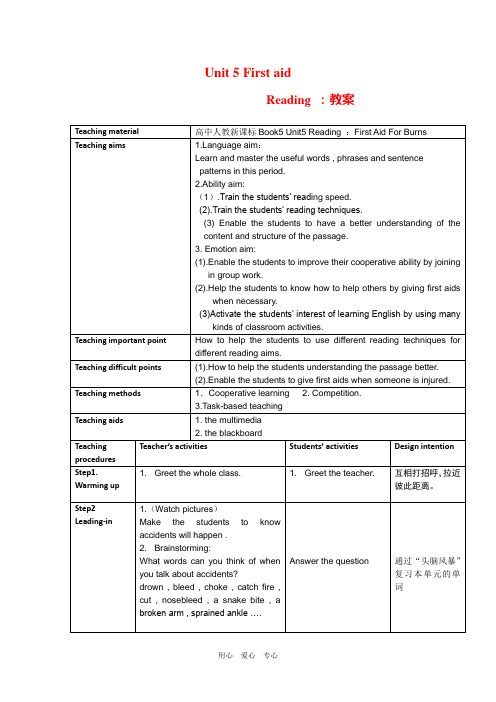
caused by hot liquids
third degree burns
Tissue under them often can be seen
Electric shocks, burning
clothes or Severe petrol fires
3. Read Part 5 and decide the following sentences true or false.
Teaching methods
1.Cooperative learning 2. Competition.
3.Task-based teaching
Teaching aids
1. the multimedia
2. the blackboard
Teaching procedures
Teacher’s activities
在整个的阅读过程中培养学生通过略读获得文章大意的能力。
让学生独立完成,培养独立学习的能力.
英语:Unit5《First aid》教案(5)(新人教版必修5)
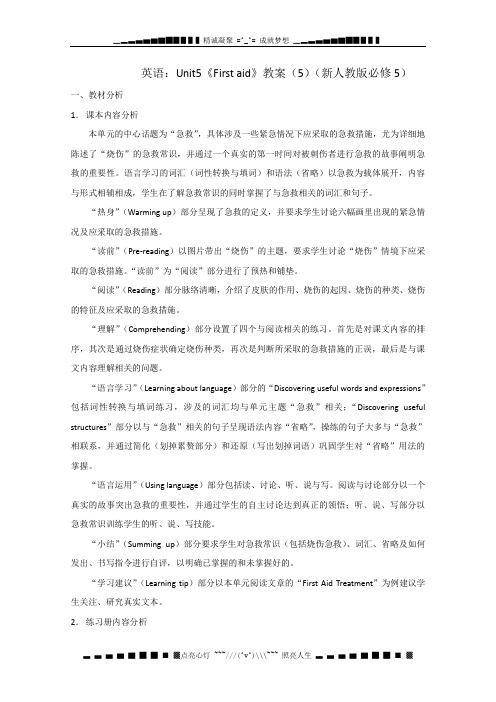
英语:Unit5《First aid》教案(5)(新人教版必修5)一、教材分析1.课本内容分析本单元的中心话题为“急救”,具体涉及一些紧急情况下应采取的急救措施,尤为详细地陈述了“烧伤”的急救常识,并通过一个真实的第一时间对被刺伤者进行急救的故事阐明急救的重要性。
语言学习的词汇(词性转换与填词)和语法(省略)以急救为载体展开,内容与形式相辅相成,学生在了解急救常识的同时掌握了与急救相关的词汇和句子。
“热身”(Warming up)部分呈现了急救的定义,并要求学生讨论六幅画里出现的紧急情况及应采取的急救措施。
“读前”(Pre-reading)以图片带出“烧伤”的主题,要求学生讨论“烧伤”情境下应采取的急救措施。
“读前”为“阅读”部分进行了预热和铺垫。
“阅读”(Reading)部分脉络清晰,介绍了皮肤的作用、烧伤的起因、烧伤的种类、烧伤的特征及应采取的急救措施。
“理解”(Comprehending)部分设置了四个与阅读相关的练习。
首先是对课文内容的排序,其次是通过烧伤症状确定烧伤种类,再次是判断所采取的急救措施的正误,最后是与课文内容理解相关的问题。
“语言学习”(Learning about language)部分的“Discovering useful words and expressions”包括词性转换与填词练习,涉及的词汇均与单元主题“急救”相关;“Discovering useful structures”部分以与“急救”相关的句子呈现语法内容“省略”,操练的句子大多与“急救”相联系,并通过简化(划掉累赘部分)和还原(写出划掉词语)巩固学生对“省略”用法的掌握。
“语言运用”(Using language)部分包括读、讨论、听、说与写。
阅读与讨论部分以一个真实的故事突出急救的重要性,并通过学生的自主讨论达到真正的领悟;听、说、写部分以急救常识训练学生的听、说、写技能。
“小结”(Summing up)部分要求学生对急救常识(包括烧伤急救)、词汇、省略及如何发出、书写指令进行自评,以明确已掌握的和未掌握好的。
高中英语Unit5《Firstaid》教案新人教版
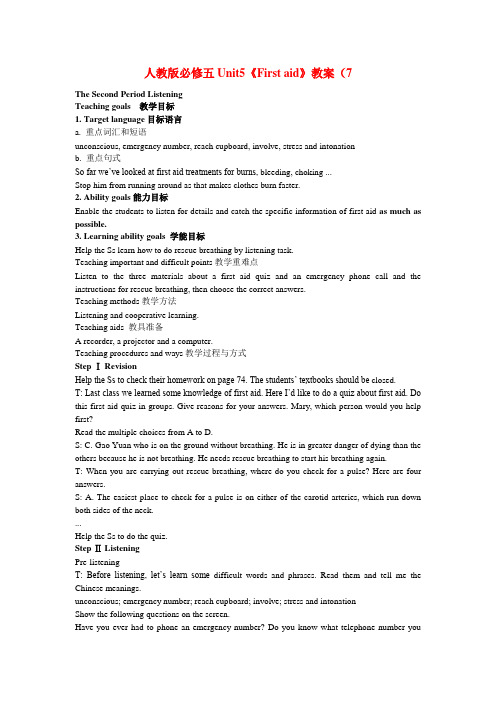
人教版必修五Unit5《First aid》教案(7The Second Period ListeningTeaching goals 教学目标1. Target language目标语言a. 重点词汇和短语unconscious, emergency number, reach cupboard, involve, stress and intonationb. 重点句式So far we’ve looked at first aid treatments for burns, bleeding, choking ...Stop him from running around as that makes clothes burn faster.2. Ability goals能力目标Enable the students to listen for details and catch the specific information of first aid as much as possible.3. Learning ability goals 学能目标Help the Ss learn how to do rescue breathing by listening task.Teaching important and difficult points教学重难点Listen to the three materials about a first aid quiz and an emergency phone call and the instructions for rescue breathing, then choose the correct answers.Teaching methods教学方法Listening and cooperative learning.Teaching aids 教具准备A recorder, a projector and a computer.Teaching procedures and ways教学过程与方式Step Ⅰ RevisionHelp the Ss to check their homework on page 74. The students’ textbooks should be closed.T: Last class we learned some knowledge of first aid. Here I’d like to do a quiz about first aid. Do this first aid quiz in groups. Give reasons for your answers. Mary, which person would you help first?Read the multiple choices from A to D.S: C. Gao Yuan who is on the ground without breathing. He is in greater danger of dying than the others because he is not breathing. He needs rescue breathing to start his breathing again.T: When you are carrying out rescue breathing, where do you check for a pulse? Here are four answers.S: A. The easiest place to check for a pulse is on either of the carotid arteries, which run down both sides of the neck....Help the Ss to do the quiz.Step Ⅱ ListeningPre-listeningT: Before listening, let’s learn some difficult words and phrases. Read them and tell me the Chinese meanings.unconscious; emergency number; reach cupboard; involve; stress and intonationShow the following questions on the screen.Have you ever had to phone an emergency number? Do you know what telephone number youwould call in a medical emergency?What telephone number you would call in a fire emergency?And what telephone number you would call in a police emergency?Let the Ss discuss these questions. Give some necessary help.Ss: 120 is the emergency phone number for the ambulance;110 for police station;119 for fire station.T: OK. When we make an emergency call, what should we pay attention to? Yes, we should re-member to tell where we are, what happened, the telephone number etc. Now, we are going to listen to an emergency phone call. Listen attentively and get the general idea.ListeningPlay the tape twice. And then ask the Ss some questions.T: What can you hear in the listening?S: The listening presents an emergency phone call in which a woman is asking for an ambulance for her daughter who has had an accident.T: I play it the second time; you need to fill in the blanks. While you are listening, you’d better make notes of the listening points. Listen to the conversation and complete the table on page 69, pay attention to the key words.Check the answers.Make the Ss understand all the four questions. Play the tape and ask them to answer the questions in pairs. And then check the answers with the whole class.T: Can you remember the phrases the operator used to try and make Mrs Grant feel more relaxed? S: Now calm down; Now take a deep breath.T: Are there any other phrases you didn’t understand?...Play the tape again and help the Ss to deal with the difficulties.Step Ⅲ Listening ( P73)Pre- listeningT: Now let’s go on to do another listening practice. Please turn to page 73. Here are some pictures of how to do rescue breathing. We call the way CPR. What do you think rescue breathing is?S: Rescue breathing is when you help someone who has stopped breathing to start breathing again. While listeningT: Listen to the instructions for rescue breathing, number the boxes for the correct order. Write an instruction under each picture. Now discuss the order in groups. Number the boxes to show the correct order of the pictures. Write an instruction under each picture.Ss: 7-5-2-4-8-6-1-31 check if conscious2 put into recovery position3 clear airway4 check if breathing5 blow into mouth and watch for breathing6 check pulse7 continue rescue breathing8 put into recovery positionPost-listeningT: Now let’s look at the pictures, can you use them as guide to tell each other how to do rescue breathing.Ss: 1. We should call for help, then check whether unconscious.2. We should put the person into the recovery position.3. We may clear anything in the airway.4. Then we should check for breathing.5. Blow into mouth using the mouth- to- mouth method.6. Check pulse.7. We should continue breathing at 15 breath a minute.8. At last when the person breaths again, put him/her in the recovery position.T: Yes, you are right. Rescue breathing is very important in our daily life. I hope one day when you need it, you can use it well.Step Ⅳ Listening (P39)T: Besides the rescue breathing, there are other ways to do first aids. Now, let’s learn more about first aid. Turn to page 39. Here is a quiz. While you listen to it, you don’t need to catch every detail. Only focus on the topi cs. Let’s listen to it and answer the questions. What topics does the teacher ask questions about? Circle the correct ones.Check the answer with the classmates. Ask some students to answer.Step Ⅴ Homework1. Search more information about first aid on the Internet.2. Prepare for reading: FIRST AID FOR BURNS.。
高中英语 Unit 5 First aid教案1 新人教版必修5
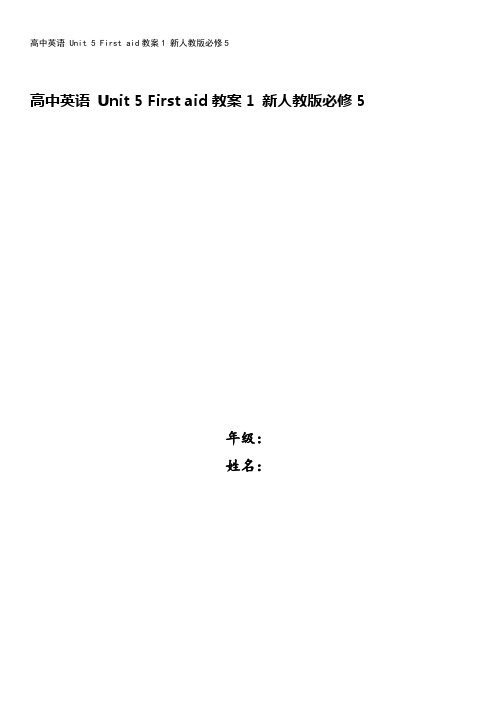
Speed is very important.
It will help the doctor greatly if you can tell him what kind of snake it was, or describe.
情感态度价值观
Students understand the development history of the United Kingdom, and be able to love their own country
教材分析
重难点
Help the students to use the expressions to describe the accidents and how to give first aid.
Choking:Make him /her spit by patting him/her on the back.
To avoid this, we shouldn’t talk or laugh when eating.
(a video aboutunconsciouschoking)
Abroken arm:Do not move the patient.
b.Enable the students to talk about different accidents and how to give first aid in different situations.
过程与方法
Different forms of activities, including pair work, group work, competition, and quiz.
人教版英语必修五Unit-5(Reading-First-Aid-For-Burns)教学设计

Unit 5 First Aid 教学设计教材分析本节课是人教版必修五第五单元的第一课时,文章以“急救”为中心话题,贴近日常生活,旨在通过阅读教学,使学生了解相关的急救知识,并能用所学的有关急救的知识,根据不同情况提出急救措施。
文章首先介绍了皮肤对人体的重要性,然后介绍了烧伤的各种起因,三种不同的烧伤程度以及他们的症状和应该采取的急救措施。
文章用了小标题,使文章脉络明晰。
通过阅读本文, 对如何处理烧伤的知识就一目了然,并会在遇到紧急情况时镇定自若地进行急救。
结合本文的文体特点,适合设计略读和精读的阅读训练,增加小组活动,以读促说,培养学生的语言综合运用能力。
学情分析经过高一英语课程的学习,高二的学生具备了一定的英语语言基础,初步掌握了高中英语学习的方法,养成了良好的学习习惯,但是英语口语表达能力有待加强和提高。
本节课的话题贴近生活,实用性强,学生在阅读本文前已具备一定的急救常识,对这一话题充满了浓厚的兴趣,因此在课前预习部分设计了急救知识小测试,和思维导图引导他们预习课文主要内容。
学生有丰富的想象力和活跃的思维,可通过参与急救处理方法的课堂活动,培养学生分析和解决问题的能力,在轻松的氛围中,激发学生开口讲英语的兴趣。
教学目标1. Knowledge aims:1) Get students to learn the useful new words and expressions in this part.2) Have students read the passage and know about burns and first aids treatment for burns.2. Ability aim:Develop students’ reading ability a nd let them learn different reading skills.3. Emotional aims:Stimulate students’ interest in first aid and learn to protect themselves or help others in the emergency.教学重难点1.How to enable students to apply what they’ve learnt to perform first aidtreatment for burns correctly.2.How to improve the Student s’ reading and speaking ability.3.How to grasp the main idea and key information quickly.教学方法Cooperative learning, Competition, Task-based reading教学过程Part1 自主探究Step1 Warming up: What is first aid1. Read the concept of first aid on Page 33 and fill in the blanks:First aid is a __________ form of help given to someone who suddenly ______ or __________ before a doctor can be found. Often the ______ or ______ is not_______, but there are other times when giving ______________ can save _____.2. Answer three more questions based on the concept. 1) Who need first aid 2) When do people need first aid 3) Why do people need first aidWatch three video clips about first aid filmed by students from our class.1. If a friend has a nosebleed, what should she doA. pinch(捏) her nose and jump up and downB. lie down and pinch her noseC. sit down, bend her head forward and pinch her noseD. sit down, bend her head backward and pinch her noseKey: C (To stop the bleeding she should sit down, bend her head forward slightly and gently pinch the soft part of the nose below the bridge. If she bent her head backwards, the blood would run down her throat and possibly make her sick. )2. Your friend was drown ed in the lake. What should be the first step when you carry out recue breathingA. clear the airwayB. blow into the victim’s mouthC. check the pulseD. check for breathingKey: A (Before doing anything else, you need to make sure that the airway is open by clearing away anything in the mouth. If you check to see whether the person was breathing first, you may be wasting time when the person cannot breathe.)3. If one of your friends gets burned when holding a hot pan with his bare hands, what kind of first aid would you perform on him Make a list of your ideas.1) _____________________________________2) ___________________________________ 3) _____________________________________4) ___________________________________ Key: Cool the area of skin; Wash it under the cold running water;Cover the wound with bandage/clean cloth;See a doctor if necessary, etc.1. Skimming: Skim through the text quickly and find out how the text is organized.Part1 The _________ of the skinPart2 _________ of burnsPart3 _________ of burnsPart4 _________ of burnsPart5 First aid _________ for burns2. Scanning: Part 1 The functions of skin1) How many layers of skin are there2) What can skin do for our bodyAn essential part of body and largest organ•It keeps you or•It your body losing water.•It is where you feel _____, _____or _____.•It gives you your .3. Scanning: Part2 The causes of burnsFind the causes of burns with the given pictures.4. Scanning: Part3&4 The types of burns and their characteristics Match the types of burns with their characteristics and pictures of description.Answer two more questions:1)Can you give some examples of first degree burns2)Which layers does third degree burns affect5. Scanning: Part 5 The treatments of skinCompetition: Put the following steps of treatment in the correct order on the blackboard.① Remove clothing using scissors if necessary.② Cool burns with cool but not icy water for 10 minutes.③ Place cool, clean, wet cloths on burns.④ Dry the burned area gently.⑤ Cover the burned area with a dry, clean bandage.⑥ Keep the burned area higher than the heart.⑦ Get the victim to the hospital if possible.设计思路:本文由5个部分组成,分别讨论了皮肤的功能,烧伤的原因、类型、特征以及治疗方法,各部分结构层次分明,细节信息较多。
高中英语:Unit5《Firstaid》学案-词汇(1)新人教版必修5

Unit 5 First aid·巧·典句·考点aid [eid ]n.& vi.帮助;救助;助【巧提示】 aid (助)→ aim(目的)【典例句】 She came to my aid.她来帮助我。
【考点聚焦】辨析aid与help:同样点 :aid与help作,都有“帮助”之意,有可通用。
不一样点 :aid是比正式的用法,盛大,在平时生活中其实不多用;help 含广,特在平时生活顶用的多,几乎所实用aid 的地方都能够用 help 取代,但在表示“救” ,用aid 不用 help 。
我的卡固定搭配first aid (患者)抢救in aid of支持,救助with the aid of sb.=with sb.'s aid在某人的帮助下aid sb.to do sth.帮助某人去做⋯⋯aid sb.in/with⋯⋯(事)帮助某人injury[ 'I n ' d ri]n . ;害【巧提示】in (在⋯⋯里) +jur(法律;法学;法理)+y(品;性;状)【典例句】 In the crash he suffered severe injuries to the head and arms.在事故中他部和双臂受了重。
【考点聚焦】 1 ) injure也可表示“ 害声誉;害感情等”。
2)同根 injured adj.受的,受委屈的3)辨析 injure,hurt与wound:injure一般指因为不测或事故而受;hurt多用于精神上的害。
hurt是受的一般用,也可指精神上的害;wound 指外,如、刀、,尤指在争中、斗中受;hurt 也可用作不及物,意“痛苦,惹起难过”。
bleed[bli :d]v.出血,流血【巧提示】 bleed( 流血 ) →blood( 血 )【典例句】 His nose was bleeding.他在流鼻血。
高中英语必修五:Unit5+First+Aid+教学设计方案.doc
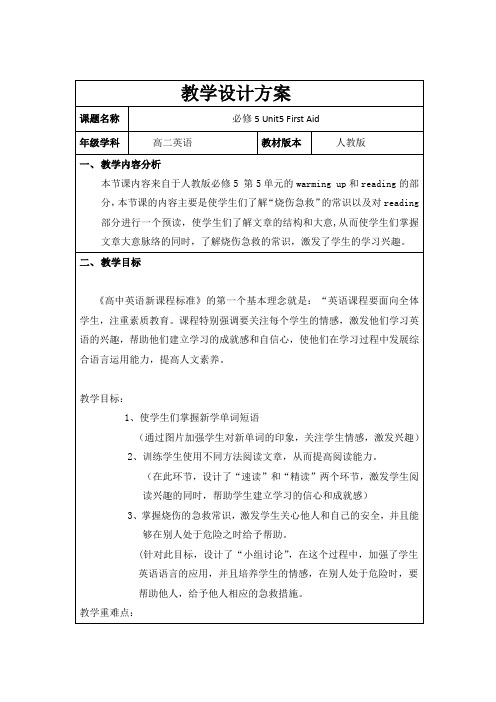
精美句子1、善思则能“从无字句处读书”。
读沙漠,读出了它坦荡豪放的胸怀;读太阳,读出了它普照万物的无私;读春雨,读出了它润物无声的柔情。
读大海,读出了它气势磅礴的豪情。
读石灰,读出了它粉身碎骨不变色的清白。
2、幸福幸福是“临行密密缝,意恐迟迟归”的牵挂;幸福是“春种一粒粟,秋收千颗子”的收获. 幸福是“采菊东篱下,悠然见南山”的闲适;幸福是“奇闻共欣赏,疑义相与析”的愉悦。
幸福是“随风潜入夜,润物细无声”的奉献;幸福是“夜来风雨声,花落知多少”的恬淡。
幸福是“零落成泥碾作尘,只有香如故”的圣洁。
幸福是“壮志饥餐胡虏肉,笑谈渴饮匈奴血”的豪壮。
幸福是“先天下之忧而忧,后天下之乐而乐”的胸怀。
幸福是“人生自古谁无死,留取丹心照汗青”的气节。
3、大自然的语言丰富多彩:从秋叶的飘零中,我们读出了季节的变换;从归雁的行列中,我读出了集体的力量;从冰雪的消融中,我们读出了春天的脚步;从穿石的滴水中,我们读出了坚持的可贵;从蜂蜜的浓香中,我们读出了勤劳的甜美。
4、成功与失败种子,如果害怕埋没,那它永远不能发芽。
鲜花,如果害怕凋谢,那它永远不能开放。
矿石,如果害怕焚烧(熔炉),那它永远不能成钢(炼成金子)。
蜡烛,如果害怕熄灭(燃烧),那它永远不能发光。
航船,如果害怕风浪,那它永远不能到达彼岸。
5、墙角的花,当你孤芳自赏时,天地便小了。
井底的蛙,当你自我欢唱时,视野便窄了。
笼中的鸟,当你安于供养时,自由便没了。
山中的石!当你背靠群峰时,意志就坚了。
水中的萍!当你随波逐流后,根基就没了。
空中的鸟!当你展翅蓝天中,宇宙就大了。
空中的雁!当你离开队伍时,危险就大了。
地下的煤!你燃烧自己后,贡献就大了6、朋友是什么?朋友是快乐日子里的一把吉它,尽情地为你弹奏生活的愉悦;朋友是忧伤日子里的一股春风,轻轻地为你拂去心中的愁云。
朋友是成功道路上的一位良师,热情的将你引向阳光的地带;朋友是失败苦闷中的一盏明灯,默默地为你驱赶心灵的阴霾。
Unit5Firstaid单元教案(人教版必修五).doc
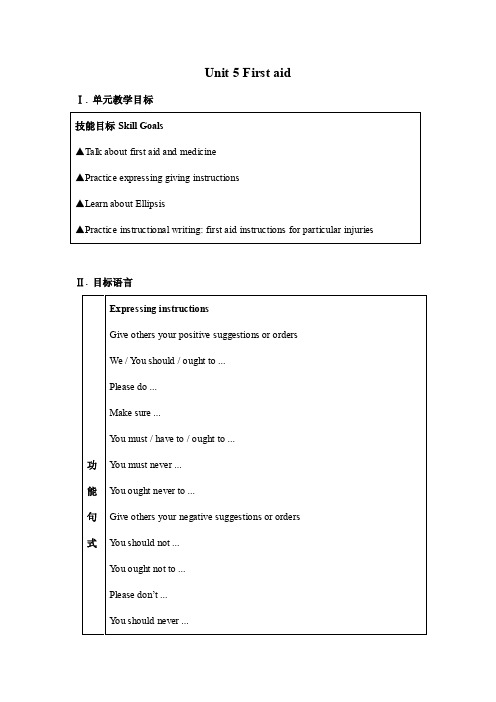
Unit 5 First aidⅠ. 单元教学目标技能目标Skill Goals▲Talk about first aid and medicine▲Practice expressing giving instructions▲Learn about Ellipsis▲Practice instructional writing: first aid instructions for particular injuries Ⅱ. 目标语言功能句式Expressing instructionsGive others your positive suggestions or orders We / Y ou should / ought to ...Please do ...Make sure ...Y ou must / have to / ought to ...Y ou must never ...Y ou ought never to ...Give others your negative suggestions or orders Y ou should not ...Y ou ought not to ...Please don‟t ...Y ou should never ...Y ou must / should never to ...词汇1.四会词汇aid, injury, bleed, ankle, choke, blood, bloody, burn, organ, poison, ray, treatment, liquid, radiation, mild, iron, tissue, electric, swell, damage, jewellery, squeeze, wound, bandage, symptom, kettle, wrist, damp, sleeve, throat, present, ceremony, bravery, towel, pressure, ambulance, authentic 2.认读词汇sprain, essential, layer, heal, blister, watery, char, nerve, ointment, infection, label, Jason, Slade, stab, scheme, bruise3.词组first aid, fall ill, electric shock, squeeze out, over and over again, in place, a number of, put one‟s hands on, catch fire, ought to, have to, stay calm, keep in mind, manage to, flow out, die of4.重点词汇injury, bleed, swell, damage, wound, damp, throat, present, bravery, should, ought to, make sure, have to语法Learn about Ellipsis1. Burns are called first degree burns, second degree burns or third degreeburns. P342. These burns affect both the top layer of the skin . P343. John was presented with his award at a ceremony which recognised the重点句子bravery of ten people who had saved the life of another. P384. They discovered that Anne Slade, mother of three, had been stabbed repeatedly with a knife. P385. It was John‟s quick action and knowledge of first aid that saved Ms Slade‟s life. P38Ⅲ. 教材分析和教材重组1. 教材分析本单元以“急救”为中心话题,旨在通过单元教学,使学生了解相关的急救知识,并能用所学的有关first aid的知识,根据不同情况提出急救措施,能牢固地掌握构词法和省略句,能写急救措施。
高中英语 Unit5 First aid教案 新人教版必修5-新人教版高二必修5英语教案
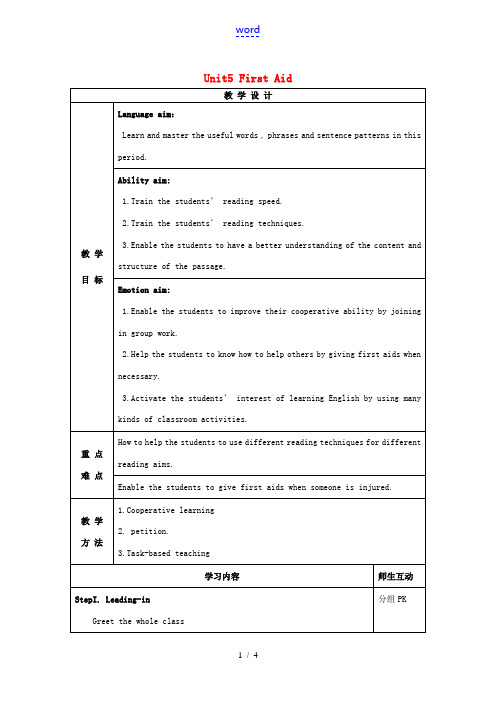
Unit5 First AidStepⅡ. Present 6 pictures and ask1.What has happened?2.How to deal with it?StepⅢ.Talk about the picture and answer the questions.1.What has happened to the little girl?2.What can we do to help her?StepⅣ. Fast readingRead the text quickly and finish the task: In which order are these topics organized in the text? Number them from 1 to 5.____ the three types of burns____ what to do if someone gets burned____ the purpose of skin____ the symptoms of burns____ how we get burnsStepⅤ. Detailed readingRead Part 1 and write down the purpose of skin:1〕Protect you against , and;2〕Keep you or ;3) Prevent you from ;4) Give you .Read Part 2 and find out the causes of burns.You can get burnt by : ________________________________________ 认真观察,各小组积极发言StepⅣ快速限时默读4’,理解文章分段及大意StepⅤ1.听录音,填写。
2.仔细阅读,从课文中找出关键词,培养学生查找kettle, steam pour out ofRead Part 3 and find out some information about types of burns.There are _______ types of burns depending on which _______ are burned._______________ affect only the _____ layer and should feel better within _______________.________________ affect both the _____ and the_______ layer. These burns are _______ and take ______________ to heal.________________ affect all ______ layers and any ______ and ______ under the skin. They are very _______ injuries and the victim must go to a ________at once.Read part 4 carefully, match the types of burns with the pictures and answer some questions.Types of burns CharacteristicsExtremely painfulRead part 5 carefully. Do you know why:1.Why should you put cold water on a burn?_______________________________________________________2.Why doesn’t a third degree burn hurt?_______________________________________________________StepⅤ.DiscussionStepⅥ.Summary 细节的能力。
Unit 5 First Aid 学案(人教版新课标必修五)
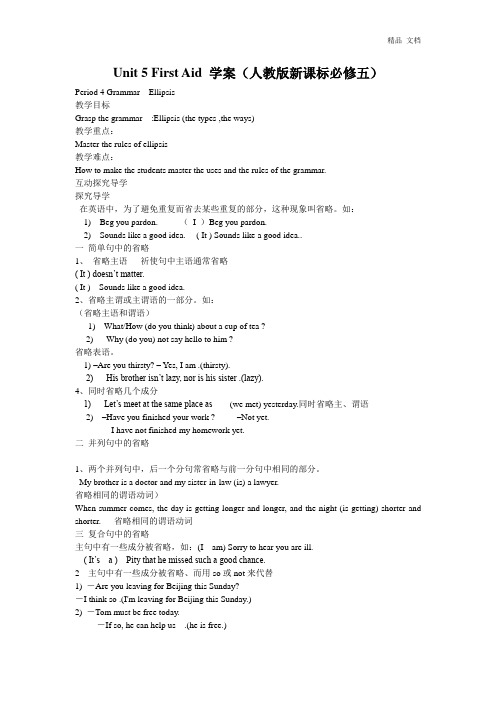
Unit 5 First Aid 学案(人教版新课标必修五)Period 4 Grammar Ellipsis教学目标Grasp the grammar :Ellipsis (the types ,the ways)教学重点:Master the rules of ellipsis教学难点:How to make the students master the uses and the rules of the grammar.互动探究导学探究导学在英语中,为了避免重复而省去某些重复的部分,这种现象叫省略。
如:1) Beg you pardon.--- (I )Beg you pardon.2) Sounds like a good idea.--- ( It ) Sounds like a good idea..一简单句中的省略1、省略主语祈使句中主语通常省略( It ) doesn’t matter.( It ) Sounds like a good idea.2、省略主谓或主谓语的一部分。
如:(省略主语和谓语)1) What/How (do you think) about a cup of tea ?2) Why (do you) not say hello to him ?省略表语。
1) –Are you thirsty? – Yes, I am .(thirsty).2) His brother isn’t lazy, nor is his sister .(lazy).4、同时省略几个成分1) Let’s meet at the same place as--- (we met) yesterday.同时省略主、谓语2) –Have you finished your work ? –Not yet.-----I have not finished my homework yet.二并列句中的省略1、两个并列句中,后一个分句常省略与前一分句中相同的部分。
人教版高中英语必修5教案Unit 5 First Aid

人教版高中英语必修5教案 Unit 5: First Aid一、教学目标1.掌握本单元的重点单词和短语,并能正确运用于实际生活中;2.能够通过阅读和听力理解有关急救和事故处理的文章,并能够从中获取关键信息;3.培养学生的合作意识和团队精神,通过小组讨论和合作实践,提高学生的自主学习和解决问题的能力;4.培养学生的英语口语表达能力和写作能力,通过角色扮演和写作练习,提高学生的语言运用能力和思维能力;5.通过跨学科的学习,培养学生的综合素质、创新思维和实践能力。
二、教学内容本单元主要内容包括以下几个方面:1.单词与短语:emergency, victim, conscious, unconscious, ambulance, injury, bandage, sprain, bleed, wound, choke, etc.2.语法:被动语态的使用;3.阅读理解:阅读有关急救和事故处理的文章,提高学生的阅读理解和信息获取能力;4.听力训练:通过听取录音材料,提高学生的听力理解能力和听写能力;5.口语表达:通过角色扮演和小组讨论,提高学生的口语表达能力和思维能力;6.写作训练:通过写作练习,培养学生的写作能力和文化意识。
三、教学过程第一课时1.温故知新:通过复习上一单元的重点单词和短语,引入本单元的话题,并激发学生的学习兴趣。
2.导入新课:介绍本单元的学习目标并让学生做预测,激发学生的学习兴趣和学习动力。
3.新课讲解:通过教师讲解和多媒体展示,讲解本单元的重点单词和短语,并进行例句的讲解和练习。
4.学习活动:分组进行单词和短语的拼写和运用训练,培养学生的团队合作和解决问题的能力。
5.拓展延伸:通过课堂讨论和小组展示,让学生拓展和延伸本单元的话题,培养学生的思维能力和创新能力。
第二课时1.温故知新:通过复习上一课的重点单词和短语,引导学生回忆上节课的内容,并复习被动语态的用法。
2.导入新课:通过展示一段有关急救的视频,激发学生的学习兴趣和对急救知识的关注。
高考英语一轮复习 Unit5 First aid精品学案 新人教版必修5

高考英语一轮复习 Unit5 First aid精品学案新人教版必修5【高考新动向】【考纲全景透析】【重点单词】1. aid n.& vi. 帮助;援助;资助表示一般意义的“帮助”或“援助”,aid 是不可数名词;表示具体意义的“助手”、“辅助用品”,aid 是可数名词。
如:A dictionary is an important aid in learning a new language.(词典是学习一种新语言的重要工具)aid 还可以用作动词,搭配为aid sb to do sth(其中的 to 不可省略),也可用于 aid sb in doing sth固定搭配first aid 急救cut off aid中止援助teaching aids教具a hearing aid助听器medical aid医疗救护with the aid of借助于= with the help ofcome to sb.’s aid帮助某人in aid of为了帮助aid vt. . 帮助,援助,救助aid sb. 帮助某人aid sb. with sth.帮助某人(做)某事aid sb. in(doing) sth.帮助某人(做)某事in aid of 支持,为……筹措first aid 急救She came to my aid.她来帮助我。
They aided the poor country with money. 他们用钱帮助那个穷乡村。
We were aided by the police.我们受到警方的援助【归纳比较】(1)with the aid of sb. = with sb.’s aid在某人的帮助下With the aid of a neighbor, he managed to put out the fire.他在邻居的帮助下把火扑灭了(2)in aid of为了帮助(或救济)...The collection is in aid of the blind.这笔募集的捐款是用来救济盲人的(3)aid sb. to do sth.= aid sb. in/with帮助某人去做……I aided her to continue her study. = I aided her in continuing her study.我帮助她继续做研究Your advice aided her to succeed.你的忠告使她取得了成功(4)do/give/offer first aid to sb. 对某人施行急救He hurt his arm during the volleyball match, and some of us gave him first aid.他在排球赛中胳膊受伤了,我们几个人对他进行了急救【即境活用】改错1)The family lived on government aids for two years._____________________________________________________________ (答案:应该为The family lived on government aid for two years. )2)We may travel on [under] the aid of a good map._______________________________________________________________ (答案:应该为We may travel with the aid of a good map.)2. treat vt. & vi.治疗;对待;款待; n. 款待;招待① She treats me like one of her family.她把我当家人来看待。
高中英语人教版必修五Unit 5 First Aid-FirstAid for Burns教案

教学设计《普通高中课程标准实验教科书英语》必修5 Unit5 First Aid-First Aid for Burns所教年级高二年级单元Unit5 First Aid-First Aid for Burns本节课以First Aid for Burns为话题,结合学生日常生活中经常发生的小意外以及处理方法,设计了warming up部分;Reading部分主要围绕First Aid for Burns主要设计主题了解如何处理不同程度的烧伤。
1.整体设计思路本单元出自是人民教育出版社出版的高二英语新教材必修5的第五单元First Aid-First Aid fo rBurns,其中心话题围绕“First Aid”展开,reading部分是本课的重点,重在训练学生精确找到阅读信息的能力,并且从阅读中获取解决实际问题的技能,如怎样判断烧伤的不同等级以及如何处理烧伤。
本课所学到的知识有利于学生解决生活中的实际问题。
Warming-up 以学生实际生活中可能遇到的小意外的照片引入话题,激发学生兴趣;阅读部分以阅读任务推动,引导学生发展阅读能力;读后部分以小组为单位学习不同小意外的处理方法,然后进行班级分享,鼓励学生以动作、语言输出所学知识,并结合实际情况学以致用。
总结部分采用新闻视频,让学生观看一名护士利用急救知识偶然在高速公路上久了一名发生车祸的陌生人的新闻报道,引导学生形成用所学拯救他人的价值观,弘扬社会主义核心价值观。
2.教学背景分析本课的授课对象是高二的学生,已经积累了一定的英语阅读技巧,但学生不习惯用英语表达。
学生情况分析:本单元所涉及的话题对于学生来说并不陌生,但是学生平时很少关注具体情况下的急救办法,希望教材分析:通过本课的学习,教会学生如何应对可能出现的生活小意外,并提高急救意识。
3.教学目标分析1.Get familiar with some useful words , phrases and sentence patterns in this passage. Teaching aims:2. Improve the reading skills3.Know some simple skills of first aid and use what we have learned to help othersaching important and difficult points:Get students to acquire some first aid skills through readingHow to output what they learnt into practice to solve some daily problems.5.教学过程设计Teaching procedures:tep2.Lead-in(Teacher should take some photos about daily accidents of students before lass.) Look at the pictures. What happened to the students? What should we do to helphem? (Draw students' attention to the topic "First Aid")2. Task1:What is first aid?A form of help given to someone who suddenly fall ill.There are other times when giving first aid quickly can save people's lives.Step3. Reading1.Fast reading:Task2:Scan for the structure of the passagePart 1:The Introduction of the skinpart 2: the characteristics of burnsPart 3: the treatment of burns2.Detailed reading:1.:What may cause burns?2: What is the feature of second degree burns?3: Why is it necessary to remove the burns?Step 4: Summarize and homework。
人教新课标高中英语必修五Unit 5 First aidUnit 5 First aid教案
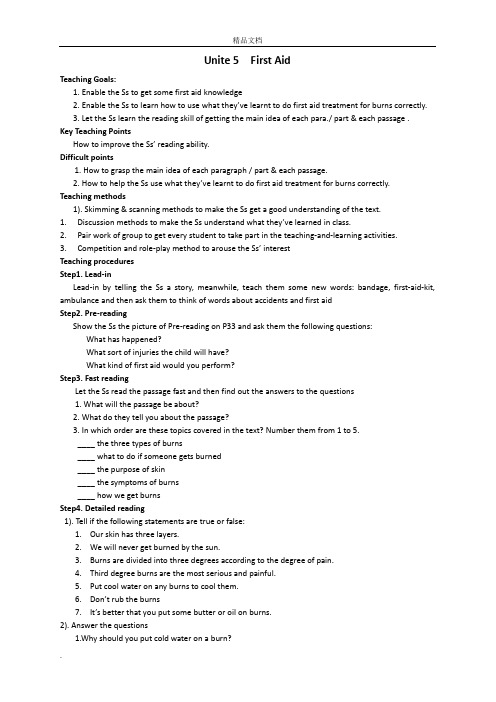
Unite 5 First AidTeaching Goals:1. Enable the Ss to get some first aid knowledge2. Enable the Ss to learn how to use what they’ve learnt to do first aid treatment for burns correctly.3. Let the Ss learn the reading skill of getting the main idea of each para./ part & each passage .Key Teaching PointsHow to improve the Ss’ reading ability.Difficult points1. How to grasp the main idea of each paragraph / part & each passage.2. How to help the Ss use what they’ve learnt to do first aid treatment for burns correctly. Teaching methods1). Skimming & scanning methods to make the Ss get a good understanding of the text.1.Discussion methods to make the Ss understand what they’ve learned in class.2.Pair work of group to get every student to take part in the teaching-and-learning activities.petition and role-play method to arouse the Ss’ interestTeaching proceduresStep1. Lead-inLead-in by telling the Ss a story, meanwhile, teach them some new words: bandage, first-aid-kit, ambulance and then ask them to think of words about accidents and first aidStep2. Pre-readingShow the Ss the picture of Pre-reading on P33 and ask them the following questions: What has happened?What sort of injuries the child will have?What kind of first aid would you perform?Step3. Fast readingLet the Ss read the passage fast and then find out the answers to the questions1. What will the passage be about?2. What do they tell you about the passage?3. In which order are these topics covered in the text? Number them from 1 to 5.____ the three types of burns____ what to do if someone gets burned____ the purpose of skin____ the symptoms of burns____ how we get burnsStep4. Detailed reading1). Tell if the following statements are true or false:1.Our skin has three layers.2.We will never get burned by the sun.3.Burns are divided into three degrees according to the degree of pain.4.Third degree burns are the most serious and painful.5.Put cool water on any burns to cool them.6.Don’t rub the burns7.It’s better that you put so me butter or oil on burns.2). Answer the questions1.Why should you put cold water on a burn?2.Why doesn’t a third degree burn hurt?3.Why do you think clothes and jewellery near burns should be removed?4.If someone has a third degree burn, why might you see tissue?3). Read the text again and then find out how many parts there are and the main idea of each part: Part1.The purpose / function of skinPart2. Causes of burns hot liquids, steam, fire, radiation, the sun, electricity, chemicalsPart3. Types of burns: First degree burns, Second degree burns, Third degree burnsPart4. Characteristics of burnsPart5 First aid treatment3). Finish off Comprehending Ex2&3Step5. Words competitionHave a competition to check the Ss’ words spellingStep6. Making a first-aid kitAn activity to let the Ss know what are included in a first-aid-kitA well-stocked(存备得好的) first-aid kit, kept in easy reach, is necessary in every home. It should include:bandage, alcohol, flashlight, thermometer, soap, sharp scissors, plastic gloves (at least 2 pairs), your list of emergency phone numbers etc.Step7. Role playWork in pairs to act out how to place an emergency call for helpStep8. SummaryThis passage doesn’t contain enough information for you to do first aid for others. Please learn more after class. Do remember: Life is precious, we should care about others and help people in an emergency and try our best to give them effective first aid if they are in danger.Period 2. Language points.1.aid 帮助,援助,赞助first aid 急救come/ go to sb’s aid 援助某人with the aid of 在…的帮助下aid sb with sth 帮助某人做某事aid sb in doing sth 帮助某人做某事Eg. ①He came to my aid at once.②He was able to find the museum with the aid of a map.③We aided him in raising the money.2. fall ill 生病属短暂性动词, 不与for + 时间段连用be ill 指生病的状态,是持续性行为, 可与for + 时间段连用His wife suddenly fell ill last week.He has been ill for a week.fall 用作系动词,后常接形容词.fall asleep 睡着fall silent 沉默不语3. save one’s life 救某人的命save one’s honor保全名誉save one’s face保全面子save one’s skin 避免受伤4 Did you or someone else give help in any of them? If so, …If so, = If it is true,Do you want to be a superman? If so, come with me!If so, = If it is so5 bite (bit, bitten)bite off more than one can chew贪多嚼不烂Once bitten, twice shy. 吃一堑,长一智。
Unit 5 First aid学案(新人教版必修5)
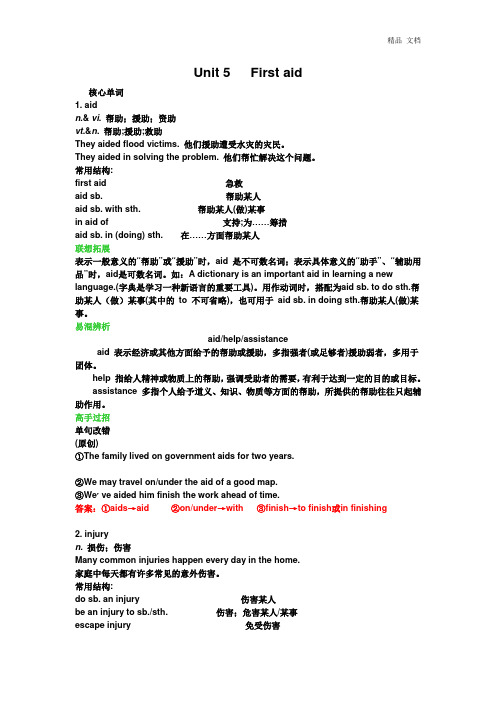
Unit 5 First aid核心单词1. aidn.& vi. 帮助;援助;资助vt.&n. 帮助;援助;救助They aided flood victims. 他们援助遭受水灾的灾民。
They aided in solving the problem. 他们帮忙解决这个问题。
常用结构:first aid 急救aid sb. 帮助某人aid sb. with sth. 帮助某人(做)某事in aid of 支持;为……筹措aid sb. in (doing) sth. 在……方面帮助某人联想拓展表示一般意义的“帮助”或“援助”时,aid 是不可数名词;表示具体意义的“助手”、“辅助用品”时,aid是可数名词。
如:A dictionary is an important aid in learning a new language.(字典是学习一种新语言的重要工具)。
用作动词时,搭配为aid sb. to do sth.帮助某人(做)某事(其中的to 不可省略),也可用于aid sb. in doing sth.帮助某人(做)某事。
易混辨析aid/help/assistanceaid 表示经济或其他方面给予的帮助或援助,多指强者(或足够者)援助弱者,多用于团体。
help 指给人精神或物质上的帮助,强调受助者的需要,有利于达到一定的目的或目标。
assistance 多指个人给予道义、知识、物质等方面的帮助,所提供的帮助往往只起辅助作用。
高手过招单句改错(原创)①The family lived on government aids for two years.②We may travel on/under the aid of a good map.③We,ve aided him finish the work ahead of time.答案:①aids→aid ②on/under→with ③finish→to finish或in finishing2. injuryn.损伤;伤害Many common injuries happen every day in the home.家庭中每天都有许多常见的意外伤害。
高中英语 英语:Unit5《First aid》教案.
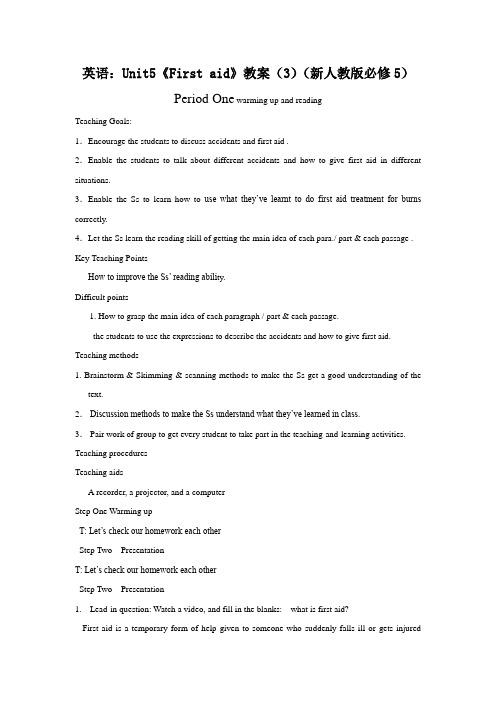
英语:Unit5《First aid》教案(3)(新人教版必修5)Period One warming up and readingTeaching Goals:1.Encourage the students to discuss accidents and first aid .2.Enable the students to talk about different accidents and how to give first aid in different situations.3.Enable the Ss to learn how to use what they’ve learnt to do first aid treatment for burns correctly.4.Let the Ss learn the reading skill of getting the main idea of each para./ part & each passage . Key Teaching PointsHow to improve the Ss’ reading abili ty.Difficult points1. How to grasp the main idea of each paragraph / part & each passage.the students to use the expressions to describe the accidents and how to give first aid. Teaching methods1. Brainstorm & Skimming & scanning methods to make the Ss get a good understanding of thetext.2.Discussion methods to make the Ss understand what they’ve learned in class.3.Pair work of group to get every student to take part in the teaching-and-learning activities. Teaching proceduresTeaching aidsA recorder, a projector, and a computerStep One Warming upT: Let’s check our homework each otherStep Two PresentationT: Let’s check our homework each otherStep Two Presentation1.Lead-in question: Watch a video, and fill in the blanks: what is first aid?First aid is a temporary form of help given to someone who suddenly falls ill or gets injuredbefore a doctor can be found. Often the illness or injury is not serious, but there are other times when giving first aid quickly will save one’s life.2. Warming-up: Brainstorming: What words can you think of when you talk about accidents and first aid?Quiz for first aid (on p74)1. The best way to treat a hurt ankle is to:A.Put an ice pack on your ankle.B.Put a heating pad(垫子)around your ankle.C.Keep on walking and jumping.2. If you get a nosebleed, gently let your head back to stop the bleeding.A. TrueB. False3. To treat a burn, you:A. Rub(擦)some butter on it.B. Hold the burnt part under cold running water.C. Put salt on the burnt part.4. You should wait at least five minutes before touching somebody who has been struck by lightening, or you might get a shock (打击). A. True B. Falsefriend has an asthma(哮喘) attack, but she doesn’t have her medicine. You’d better:A. Get a paper bag for her to breathe into.B. Get her a cup of coffee.C. Take her outside for fresh air.6. To treat a choke, you should make him /her spit by patting him/her on the back.A. TrueB. False7. If someone is having a heart attack, you should first:A. Call 120B. Perform CPR (心肺复苏)person would you help first?___A Li Yan who has cut her foot on glassB Xue Jin whose nose is bleedingC GaoY uan who is on the ground not breathingD Wang Feng who has broken her arm. carrying out rescue breathing, how many times a minute should you blow air into the victim’s mouth? ______. A 4 B 8 C 15 D 2010. How would you stop severe bleeding? ___A cover the wound with plasticB wash the woundC do nothing as the bleeding will stop by itselfD put a bandage over the wound and then press on it5 A friend is choking on a piece of food and is coughing badly. What should you do?___A nothingB carry out rescue breathingC have her lie down and restD slap her four or five times on her back4. A snake bite; a nose bleeding; a sprained ankle; choke; drown; burn; a broken Step Three Group discussioa. What happen in each picture and what kind of first aid should you give in the following situatioTalk about different situations and the way they should give first aid.Qs: Turn to page 33, look at the happened in each picture? What kind of first aid should you give?A snake bite: A snake has bitten him on his leg.(The person bitten must get to a doctor or hospital at once; /Speed is very important. /It will help the doctor greatly if you can tell him what kind of snake it was, or describe the situation .)Bleeding: She has cut her arm with some broken glass and is bleeding badly.(Try to stop the bleeding;/Press a handkerchief onto the bleeding point and hold it there;/Hold up the part of body which is bleeding if possible.)*(watch the video about how to deal with bleeding )A sprained ankle: He has badly sprained his ankle.(Tied with medical bandage. /It is better to avoid walking with the injured ankle. /It is correct to use ice bag for removing pain and bleeding, and also not influence our own body healing.)*( a video about a sprained ankle)Choking : She is choking on a piece of food (Make him /her spit by patting him/her on the back./ Don’t eat too fast and don’t forget to chew your food./To avoid this, we shouldn’t talk or laugh when eating.)*(a video about unconscious choking)A broken arm : She has broken her arm. (Do not move the patient. /Send for an ambulance at once. /Treat for shock if necessary.A bleeding nose: He has a nose/a nose bleed.(Stay calm. / Breathe through the mouth, not the nose. / Sit up and bend the head slightly forward. / Pinch捏both nostrils鼻孔shut using a thumb and forefinger./ Spit out any blood that collects in the mouth.Step Two Pre-reading:1. Questions for the picture on P33:What has happened? What sort of injuries the child will have?What kind of first aid would you perform in the situation of burning?Key: Cool the area of skin; Wash it under the cold running water.Cover the wound with bandage/clean cloth. See a doctor if necessary.Step Three Fast readingLet the Ss read the passage fast and then find out the answers to the questions1. What will the passage be about?2. What do they tell you about the passage?3. In which order are these topics covered in the text? Number them from 1 to 5.In which order are these topics covered in the text? Number them from 1 to 5.(P35Ex1) (3) the three types of burns(5) what to do if someone gets burned(1 ) the functions of the skin(4) the symptoms of burns(2) how we get burnsStep Four Detailed reading Fill in the blankscan skin do for our body ?.Protect you against diseases, poisons and the sun’s harmful rays..Keep you warm or cool..Prevent you from losing water..Give you sense of touch.of burnsYou can get burnt by : hot liquids; steam; fire radiation; the sun electricity and chemicals of burnWhat are they?degree burns.2. Second degree burnsdegree burns4. Label these pictures first, second and third degree burns.(P35 Ex2)5.Fill in the blanks Types & characteristics of burns (based on page 34)6..Answer the questions(Page35 Ex3)1).Why should you put cold water on a burn?Because the cold water stops the burning process, stops the pain and reduces the swelling.2). Why doesn’t a third degree burn hurt?Because in the third degree burn the nerves have been damaged. If there are no nerves, there is no pain.3). Why do you think clothes and jewellery near burns should be removed?Because bacteria from the clothes and jewellery could infect the burns.4). If someone has a third degree burn, why might you see tissue?Because all the layers of the skin have been burnt showing the tissue underneath.7.Decide whether the first aid treatment is Right (R) or Wrong (W). (35 Ex4)。
最新人教版高中英语必修五unit 5《first aid》教案.doc
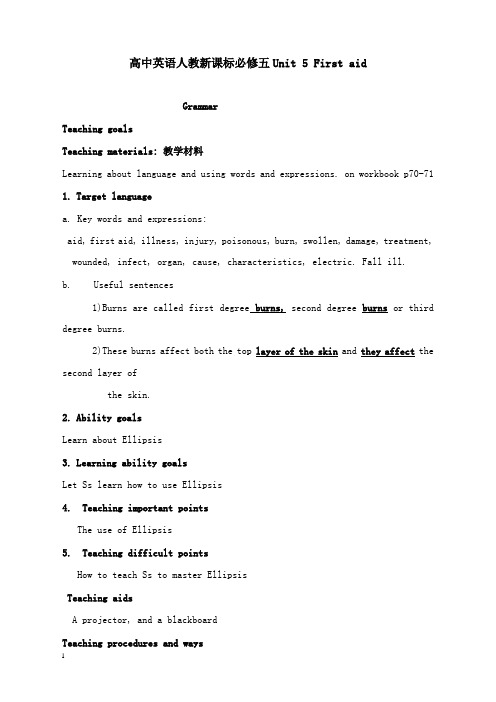
高中英语人教新课标必修五Unit 5 First aidGrammarTeaching goalsTeaching materials: 教学材料Learning about language and using words and expressions. on workbook p70-711.Target languagea. Key words and expressions:aid, first aid, illness, injury, poisonous, burn, swollen, damage, treatment, wounded, infect, organ, cause, characteristics, electric. Fall ill.eful sentences1)Burns are called first degree burns, second degree burns or third degree burns.2)These burns affect both the top layer of the skin and they affect the second layer ofthe skin.2.Ability goalsLearn about Ellipsis3.Learning ability goalsLet Ss learn how to use Ellipsis4. Teaching important pointsThe use of Ellipsis5. Teaching difficult pointsHow to teach Ss to master EllipsisTeaching aidsA projector, and a blackboardTeaching procedures and waysStep 1 Revision1.Greet the whole class as usual2.The teacher checks the students’ homework.Step 2 Word StudyT: Now please open your books and turn to Page 36. Let’s learn “Learning about Language”.First let’s do Discovering useful words and expressionsplete the table with the correct verbs, nouns or adjectives.T: Let’s do some more exercises about new words. You are to explain the words on the screenin English and then fill in the blanks.(ask students to explain or guess the meanings of the words)plete the questions with words from the text.The students will try to complete the exercises. Later the teacher will ask some of them to read each of the sentences and tell the class the answers.Suggested answers:Step 3: GrammarT: Let’s look at the next, Grammar (page 91)Present some sentences and encourage the students to find out which words have been left out.T: Observe the following sentences and discuss with your partner to find out what have been left out. Let me show you an example. As we know, when people want the speaker to repeat what he said, they usually say “ Beg your pardon.” Then it is called Ellipsis. The subject “I” has been left out, without changing the meaning of the sentence .OK, now it’s your turn to find out what have been left out.1.Haven’t seen you for ages.2.Some more tea?3.Sounds like a good idea.4.Doesn’t matter.5.Sorry to hear that.6.Pity you couldn’t come7.This way, please.8.Terrible weather!9.Joining us for a drink?10.Going to the supermarket?Suggested answers:1.I haven’t seen you for ages.2.Would you like some more tea?3.That/It sounds like a good idea.4.It doesn’t matter.5.I’m sorry to hear that.6.It’s/ What pity you couldn’t come7.Step this way, please.8.What terrible weather it is!9.Are you joining us for a drink?10.Are you going to the supermarket?Step 4 PractisingDiscovering useful structures (page 37)1.In groups, look at these pairs of sentences. Discuss the differencebetween A and B in each pair. Also discuss which is the better sentence,A orB and Why.(page 37)2.Rewrite these sentences taking out the unnecessary parts.1)The burn that she got from the iron was red and ( it was )very painful2) A boy was on the left side of the sick woman, and a girl was onthe right (side of the sick woman.)3)She has a daughter (who is) in hospital.4)He went to the doctor because he had to go to( the doctor).5)Did she pass the first aid test that she did yesterday (or didn’t she pass)?6)She could not decide whether to send him to hospital or not (to sendhim to hospital).7)When your nose is bleeding, you should bend forward so that the bloodruns out of your nose and( the blood) doesn’t run down your throat. 8)Only some of the students have done a first aid course but most ofthe students haven’t (done a first aid course).3.These sentences are correct. However, one or more words have been leftout. Rewrite each sentence on the top of the next page to include the missing words.1)The cottage (that is) surrounded by a wall belongs to the localgovernment.2)The first book I read this term was more interesting than the second(book I read this term).3)To her teacher’s surprise, she did better in her first aid examthan(it was) expected.4)I don’t think they have returned from the hospital, but they mighthave ( returned from the hospital).5)He wanted to help the accident victim but his friend didn’t (wantto help the accident victim).6)You can borrow my first aid notes if you want to (borrow my firstaid notes).4.Show the students the slides with some multiple choices exercises aboutthe Ellipsis.1)---- Tomorrow is a holiday. Why are you doing your homework?-----I am doing these exercises now so that I won’t have _____ on Sunday.A. itB. themC. forD. to2)----Shall I invite Ann to my birthday party tomorrow evening?----Yes. It’ll be fine if you______.A. areB. canC. inviteD. do3)---- Aren’t you the manager?-----No, and I______A.don’t want toB. don’t want to beC. don’t want beD. don’t want4)---- I’ll be away on a business trip. Would you mind looking after my cat?-----Not at all______.A. not toB. not to doC. not do itD. do not to5)----- Won’t you have another try?------ ________.A.Yes, I will haveB. Yes, I won’t haveC. Yes, I won’tD. Yes,I will6)-----I won’t do it any more.-----_______?A. Why notB. Why don’t do any moreC. Why not doD. Why don’t7)-----Do you think it will snow tomorrow?------______?A.I don’t thinkB. No, I don’t thinkC. I don’t think soD. No, I don’t so8)-----Have you fed the cat?------No, but______.A. I’mB. I amC. I’m just goingD. I’m just going toStep 5 Homework1. Go over the usage of Ellipsis.2. Finish listing structures on Page 71 Ex 1 and Ex 23. Prepare Reading and discussing on Page 38。
人教版高中英语必修5 Unit 5 First aid 学案4

Unit 5 First aid【学习目标】掌握本单元的常用词汇表达。
【学习重难点】熟练记住常用词汇与词组。
【学习方法】速读、细读、归纳、练习【学习内容】一、重点词汇1. aid vt. 获得;学到I aided him with money.我资助了他。
A good dictionary can aid language learning.一部好词典有助于语言学习。
Aid to the Third World is at present little more than a drop in the ocean.目前对第三世界的救助不过是杯水车薪。
●用法拓展aid sb. with sth.帮助某人某事aid sb. in (doing) sth.帮助某人做某事first aid急救foreign aid外国援助with the aid of在……的帮助下即境活用翻译句子①这项工作要用计算机协助完成。
(with the aid of)________________________________________________________________________②他们被指控帮助他逃跑。
(aid sb. in sth.)________________________________________________________________________ 答案:①The work should be done with the aid of the computer.②They were accused of aiding him in his escape.2.squeeze vt. & vi. 榨;挤;压榨①She tries to squeeze her feet into shoes that are too small.她竭力把脚挤进那双太小的鞋里。
②Can't you squeeze more juice out of that lemon?难道你不能从那个柠檬里挤出更多的汁吗?③We squeezed out of the crowd.我们从人群中挤了出来。
- 1、下载文档前请自行甄别文档内容的完整性,平台不提供额外的编辑、内容补充、找答案等附加服务。
- 2、"仅部分预览"的文档,不可在线预览部分如存在完整性等问题,可反馈申请退款(可完整预览的文档不适用该条件!)。
- 3、如文档侵犯您的权益,请联系客服反馈,我们会尽快为您处理(人工客服工作时间:9:00-18:30)。
Unit 5 First aid
核心单词
1. aid
n.& vi. 帮助;援助;资助
vt.&n. 帮助;援助;救助
They aided flood victims. 他们援助遭受水灾的灾民。
They aided in solving the problem. 他们帮忙解决这个问题。
常用结构:
first aid 急救
aid sb. 帮助某人
aid sb. with sth. 帮助某人(做)某事
in aid of 支持;为……筹措
aid sb. in (doing) sth. 在……方面帮助某人
联想拓展
表示一般意义的“帮助”或“援助”时,aid 是不可数名词;表示具体意义的“助手”、“辅助用品”时,aid是可数名词。
如:A dictionary is an important aid in learning a new language.(字典是学习一种新语言的重要工具)。
用作动词时,搭配为aid sb. to do sth.帮助某人(做)某事(其中的to 不可省略),也可用于aid sb. in doing sth.帮助某人(做)某事。
易混辨析
aid/help/assistance
aid 表示经济或其他方面给予的帮助或援助,多指强者(或足够者)援助弱者,多用于团体。
help 指给人精神或物质上的帮助,强调受助者的需要,有利于达到一定的目的或目标。
assistance 多指个人给予道义、知识、物质等方面的帮助,所提供的帮助往往只起辅助作用。
高手过招
单句改错
(原创)
①The family lived on government aids for two years.
②We may travel on/under the aid of a good map.
③We,ve aided him finish the work ahead of time.
答案:①aids→aid ②on/under→with ③finish→to finish或in finishing
2. injury
n.损伤;伤害
Many common injuries happen every day in the home.
家庭中每天都有许多常见的意外伤害。
常用结构:
do sb. an injury 伤害某人
be an injury to sb./sth. 伤害;危害某人/某事
escape injury 免受伤害
repair injury 赔偿损害
serious/severe injuries 重伤
a slight injury 轻伤
In the crash he suffered severe injuries to the head and arms.
在事故中他头部和双臂受了重伤。
易混辨析
injure/wound/hurt
injure指人在意外事故中受到的伤害,用于无生命物体的损坏,更多用于表示对人的某个部位的损伤。
wound 指利器或子弹对肉体造成的伤害。
是出血的、严重的伤,特指战场上的受伤。
也指感情受伤。
hurt 指的伤害与injure 同样严重,也可指较轻的疼痛,常指因不小心而引起的痛苦或意外地受到伤害。
hurt 也可指对人的感情的伤害。
Your remark may injure her pride.
你的话也许会伤她的自尊。
Blood gushed from his wound.血从他的伤口涌出。
Hurt other people, hurt yourself.害人害己。
高手过招
选词填空(injure/hurt/wound) (原创)
①Ten soldiers were killed and thirty serious .
②He was deeply by her dishonesty.
③I my back lifting that box.
④In the traffic accident ten were killed and eight were .
⑤She felt at your words.
⑥The bullet him in the shoulder.
答案:①wounded ②hurt ③hurt ④injured ⑤hurt ⑥wounded
3. situation
n. 形势;处境;事态;局面;位置
易混辨析
situation/state/condition
situation指一定时期内总的情况、形势、事态,亦可指国际、国内形势,是可数名词。
state用单数形式表示人或事物的情况及状况,如外貌、心理、外观等方面,可与不定冠词连用,常用于in a state of或in a... state。
condition的单数形式表示人或物本身的状况,在这个意思上与state相近;而复数形式则指事物之外的环境与情况,与circumstances意思相近。
When he later grew to dislike Eliza, he faced a difficult situation.
当他接下来对伊丽莎的讨厌与日俱增的时候,他陷入了一种困难的境地。
After that I give the students various situations and they make up sentences about them.
从那以后,我提供给学生各种各样的情境,他们依照这些情境造句。
His business is in a good state. 他的生意很好。
The condition of the house was so bad that nothing could make it safe to live in.
房屋的条件太差了以至于不能安全地住在里面。
温馨提示
situation与condition, occasion, point, case一样,后常用where, in which引导定语从句。
Can you imagine a situation where/in which you can use the word?你能想像出可以使用这个单词的语境吗?
高手过招
用适当的关系代词或关系副词填空(原创)
①He,s got himself into a dangerous situation he is likely to lose control over the plane.
②I can ,t think of the situation I meet my father.
③They have to think of a good idea to cope with the situation they face. 答案:①where ②where ③that/which
4. damage
vt.& n.损害;毁坏
易混辨析
ruin/destroy/damage
ruin强调毁灭的彻底性,并且是一次性的行动。
这种毁灭也许力量不是很大,但其严重性却使其不能修复,它强调的是毁坏的长期结果。
